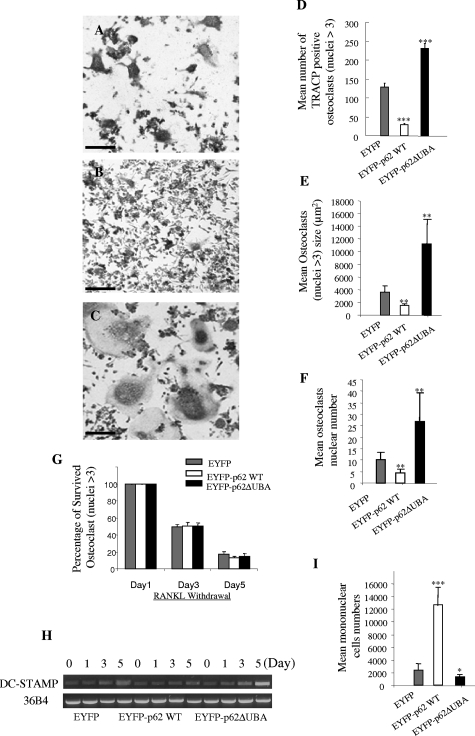Figure 2-6923.
The effect of overexpression of EYFP-p62WT or EYFP-p62ΔUBA on osteoclast size, multinucleation, and survival. RAW264.7 cells stably expressing EYFP-p62WT or EYFP-p62ΔUBA were cultured in the presence of RANKL. After 5 days, the cells were fixed with 4% paraformaldehyde and stained for TRACP activity. A–C: Representative images of TRACP staining of OCLs from one of the three experiments are shown. D–F: Quantitative analysis shows the mean number of TRACP-positive OCLs (D), mean OCLs sizes (E), and mean OCLs nuclei numbers (F). G: Similar experiments were performed in which RAW264.7 cells stably expressing EYFP-p62WT, EYFP-p62ΔUBA, or EYFP were cultured in the presence of 100 ng/ml RANKL for 5 days. Fresh medium with no RANKL was then replaced and cells were continued in culture for an additional 1, 3, and 5 days. Cells were fixed, and the number of surviving osteoclasts (nuclei >3) were counted. The effect of overexpression of p62WT, EYFP-p62ΔUBA, or EYFP fusion proteins on OCL survival was quantified by the ratio between the OCLs remained on the third or fifth day after RANKL withdrawal and the initial number of osteoclasts present on the first day of RANKL withdrawal. H: Representative results from three independent experiments showing semiquantitative RT-PCR analysis of the effect of overexpression of p62WT or p62ΔUBA on DC-STAMP gene expression during RANKL-induced RAW cell differentiation. I: The total number of mononuclear cells presented in p62WT, EYFP-p62ΔUBA, and EYFP cultures after 5 days of RANKL stimulation were counted. Four representative views of images were taken from cultures. *P < 0.05; **P < 0.01; ***P < 0.001. Scale bars = 50 μm.

